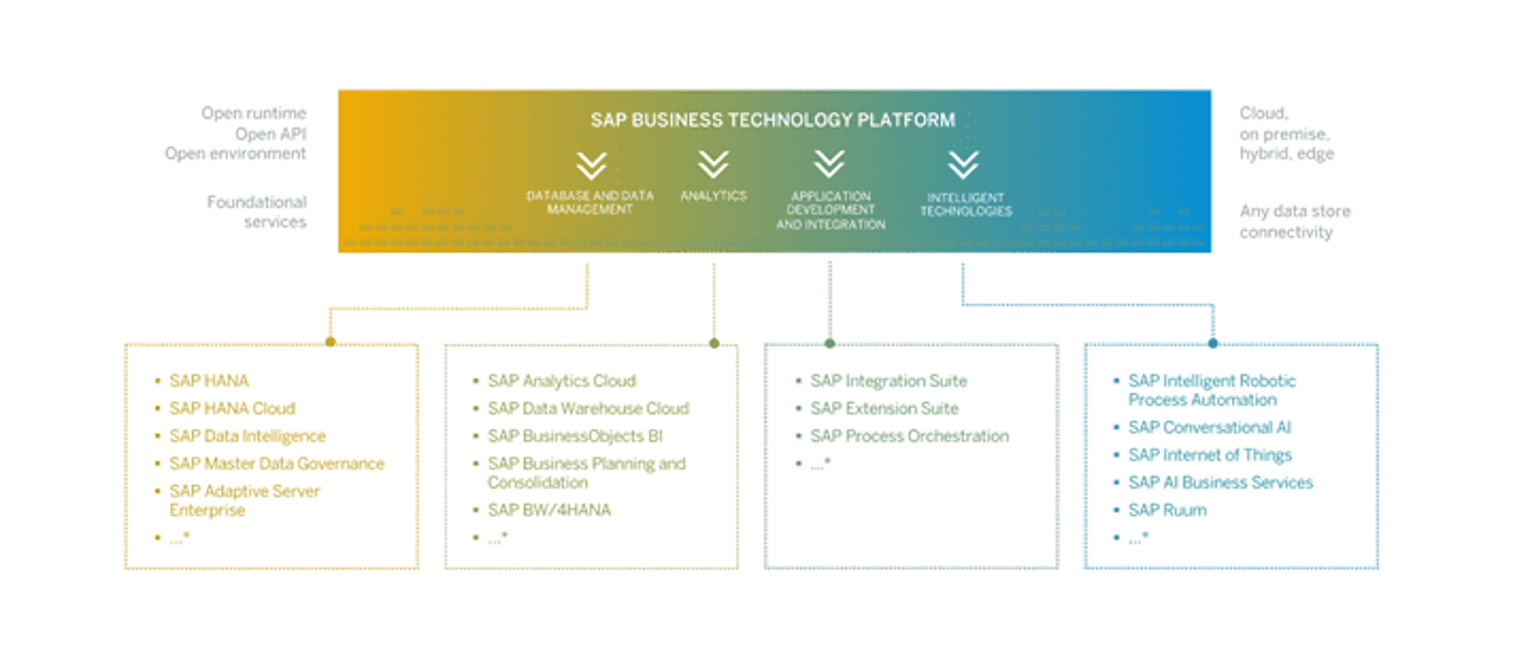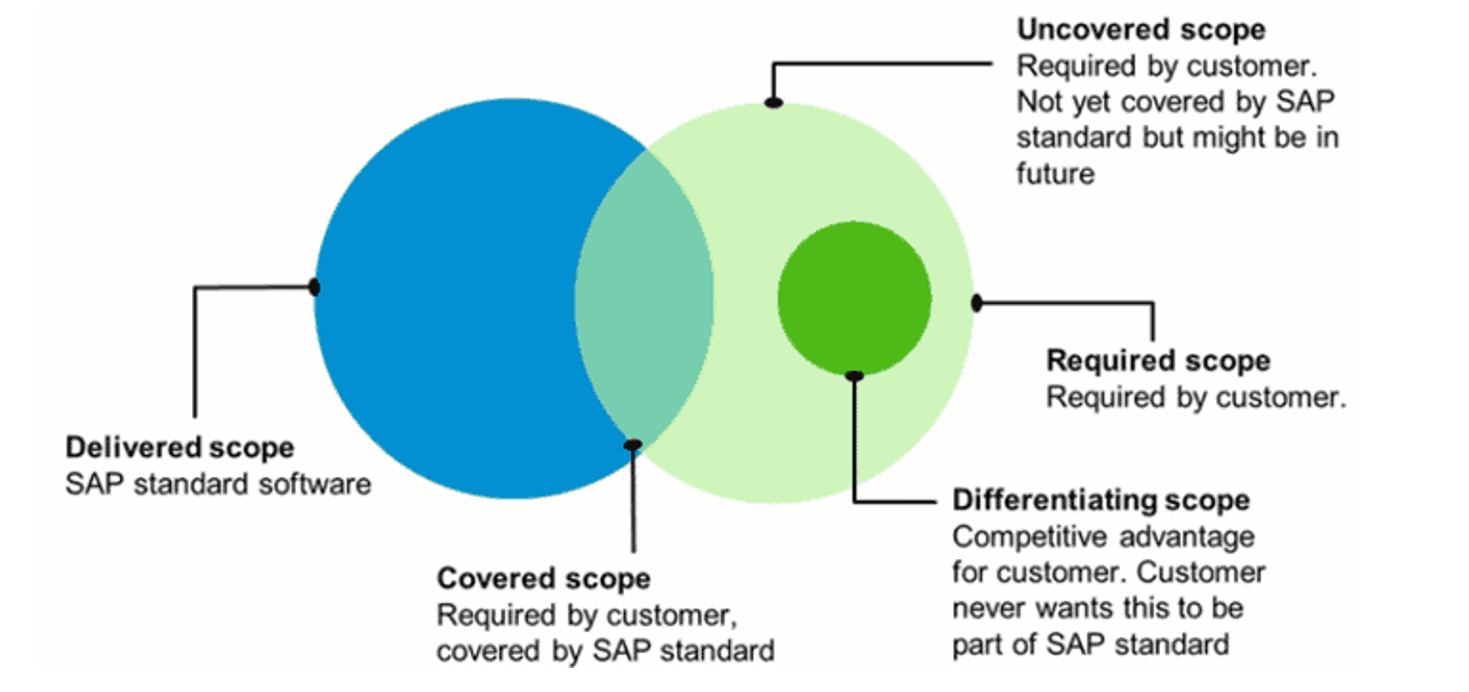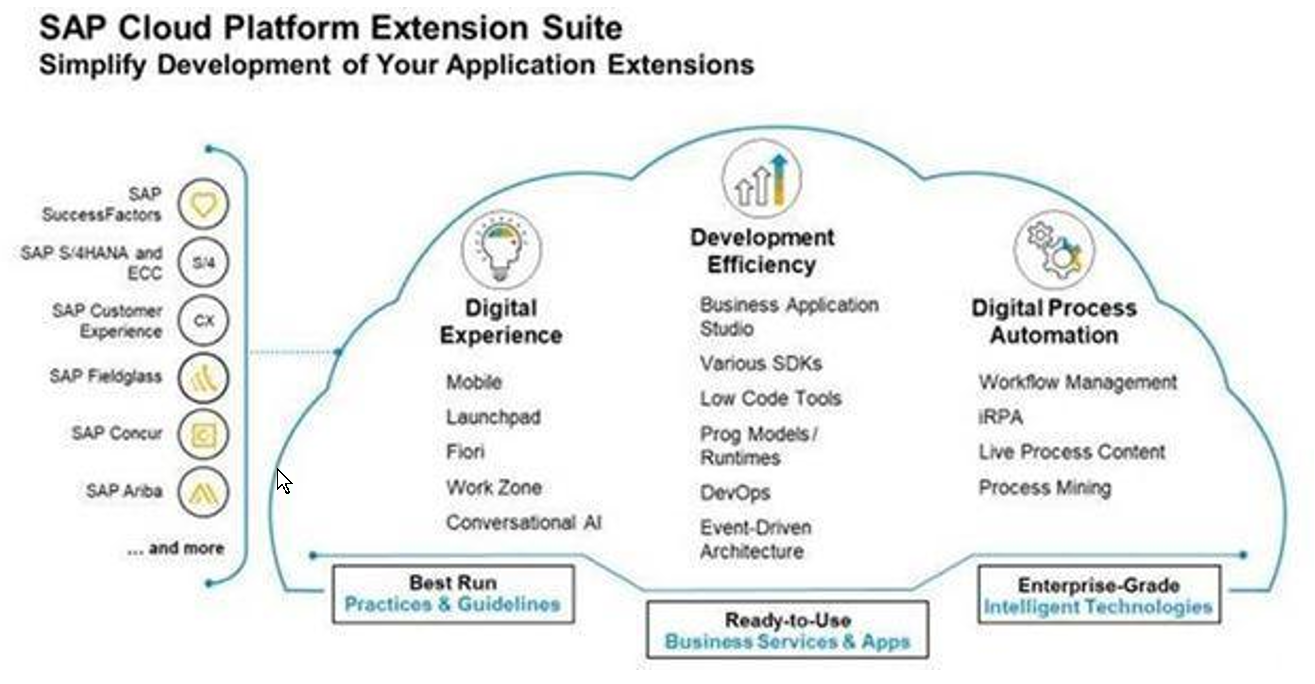Jonathan Andre is a lead ABAP developer at IT Partners. Jon has over 10 years experience with SAP, with a concentration on ECC SD, MM, and IS-OIL modules. Jon’s focus has been in the areas of ABAP OOP, ABAP Web Dynpro, and ABAP for HANA and RESTful ABAP development. He can be reached at [email protected]
You may have heard of the SAP Extension Suite, which is powered entirely by SAP’s Business Technology Platform (SAP BTP). But what is it all about? How can you as a developer or business benefit from the SAP Extension Suite? And more importantly, HOW and WHERE should you start? Well, this depends on the capabilities of your team and your overall SAP-system landscape. Let’s start with an overview and try and answer some questions. What are extensions in SAP? What is SAP Extension Suite?
You likely use the SAP S/4HANA platform to manage your business processes. Until some years back, the trend was having an S/4HANA system running on-premise or with a specific cloud vendor. With the rising popularity of cloud-based systems, more and more businesses now use SAP S/4HANA Cloud.
In the past, developers created large ABAP extensions on their systems or onto clients’ on-premise systems to extend the functionality of S/4HANA. It is impossible to develop the same extensions on a S/4HANA Cloud system since this is somewhat of a shared system. Client extensions within a shared S/4HANA system, known as in-app extensions, will only meet individual needs to some extent. You can choose between in-app and side-by-side extensibility if you need an extensive extension of your SAP S/4HANA Cloud system. Here is some information on the three extensibility alternatives for apps on SAP S/4HANA.
Classic Extensibility
It entails the use of standard extension and customization SAP technologies like Customer Exits, the Enhancement Framework, and CDS View extensions. Since ABAP is the most frequently used technology, classic extensibility is sometimes called ABAP custom development. Classic extensibility is tightly tied with SAP-delivered codes with customizations on the application servers. The approach is highly flexible, allows you to use classic development techniques and tools, and has rich functions and features.
However, there is a missing clear interface between extensions and the SAP code, which might lead to issues when extending. Upgrades in classic extensibility require regression testing, adaption efforts, and high planning. Automated software updates in S/4HANA Cloud run parallel for all clients, so the classic extensibility is unavailable. Though available for On-Premise and Private Cloud editions of S/4HANA, it is only recommended once other options have been exhausted.
In-app extensibility
This provides a framework on which you can build SAP Fiori-based customization within the S/4HANA system. It used the Custom Logic app and Custom Field app to provide no-code or low-code tools. As such, even non-developers can add fields and simple ABAP. The ABAP code in this option is decoupled from your standard SAP code stack, so it will not affect your upgrade process.
In-app extensibility is best for extensions for S/4HANA users who want to focus on S/4HANA processes and data only. Its main advantage is that you do not need advanced technical skills or external tools to alter existing objects. You can handle a large number of tasks using the tools on S/4HANA Cloud. These tools are entirely web-based.
Side-By-Side Extensibility
With side-to-side extensibility, you can develop custom applications, consume existing apps and develop dependent extensions. The main goal of this extensibility option is to create extensions that are loosely coupled but integrate seamlessly. This means you will get extensions that are independent of lifecycle management and cloud operation of S/4HANA Cloud.
With side-by-side extensibility, you can develop processes quickly when you subscribe to the necessary services, which are instantly available on the cloud. Therefore, you do not rely on an infrastructure team for tools. Moreover, the total cost of ownership of this extensibility alternative is low because there is no manual system upgrade during your services’ lifecycle. Everything is automatically handled by SAP.
The related object types of side-by-side extensibility are IDocs, APIs, SOAP, OData, BAPIs, events, and APIs. Side-by-side extensibility is used for multitenant or custom applications, non-ABAP and ABAP development, apps for diverse target groups, and SaaS solutions created by partners. The accepted choice when building an extension for SAP cloud solutions is the Business Technology Platform (BTP) through its Extension Suite.
You can use the cooking analogy to understand BTP (Business Technology Platform) from SAP. When you want to prepare a good dish, you need a recipe then you will visit a food store to pick all the ingredients you need. With these steps, you are now ready to start cooking your meal. BTP, like cooking, is not a single system. This is an umbrella for many things, just like a food market. On the platform, you choose from the many services hosted in the cloud, similar to cooking ingredients. Once you pick the right ingredients for your solution, the meal, you can proceed to create an engaging digital experience while building or extending applications quickly.
SAP BTP was formerly known as the SAP Cloud Platform and was launched in 2013. It was rebranded to SAP BTP in 2021. The solution has a ‘’pick and choose’’ policy, meaning that you will only pay for what you need and not the entire stack of services. There are also guides on how you can combine services to get a customized solution.
The services in BTP are like the products in the food market grouped in different aisles. They are broadly categorized into the four categories below with different offerings as depicted in the figure:
- Analytics
- Database and data management
- Intelligent technologies
- Application development and integration
The main areas that a developer will focus on in SAP BTP are the Integration and Extension Suites. The Integration Suite is an IPaaS (integration platform as a service) that enables you to integrate cloud and on-premise applications using APIs, domain models, connectors, events, and out-of-the-box packs to jumpstart the integration. Please see the following post for more information on the SAP Integration Suite.
Standard SAP software will not cover the scope of all your company processes. You will always be looking for a new report, new functionality, and a new app with the multiple needs of today’s business world. This is where the BTP Extension Suite comes into play. It offers services that allow the extension of your regular SAP solution with new applications. Here is a diagram that summarizes the challenges you might be facing when using SAP software.
Primary Sections of the SAP Extension Suite
The services, best practices and technologies in SAP Extension Suite that enable its effective operation can be categorized into three primary sections summarized in the figure below.
Digital Experience
In this category, the tools help your company build and run an engaging and consistent user experience through SAP Fiori-based web applications, mobile apps, and conversational bots. Developers and end users can use the tools to consume information, collaborate and create business content. Some of the best examples in this category are SAP Work Zone, SAP Conversational AI, and SAP Launchpad.
Digital Process Automaton
In this category, the tools will help you automate, adapt and enhance business processes beyond what you can achieve with standard solutions. The tools are meant for the process owner. Some convenient low-code tools are also available to support the customization and use of process templates to build processes from scratch and adhere to local compliance regulations. Live process content packages and SAP Workflow Management are in this category.
Development Efficiency
In this area, the tools help you quickly build extensions using SDKs (software development kits) and the recommended application architectures meant to streamline their daily tasks. Graphical low-code development tools like the SAP Business Application Studio allow users to collaborate with developers on processes, user experience, and data while increasing development efficiency. Some of the solutions in this category include SAP Business Application Studio, SAP Cloud Application Programming Model, and the ABAP environment.
With SAP Extension Suite, you get a complete set of capabilities that allow you to develop, run and test your applications quickly and economically using its reusable features that guarantee consistency across your landscape while leveraging your expertise and existing investments. Below are the advantages of investing in this solution.
- The SAP Extension Suite enhances people’s engagement and productivity because of the delivery of contextualized and harmonized experiences.
- You will jump-start development through the use of powerful mobile solutions and pre-built components supported by cloud-native and low-code development alternatives.
- Companies can realize a faster ROI from their applications by leveraging digital process automation solutions that optimize and automate tasks and processes.
- You can build an exceptionally resilient business that is flexible enough to customize and adapt your business processes. The Extension Suite also allows you to identify areas where you can improve and manage process performance using data-based insights.
- It allows you to gain a competitive advantage for your company to survive and thrive in the current dynamic business environment. With the Extension Suite, you can drive agility in periods of rapid change.
- With the SAP Extension Suite, you can build intelligent workspaces extending SAP applications.
- The solution allows the automation of business processes and the creation of guided process flows for task completion.
- You can build new applications focused on low code.
- With SAP Extension Suite, users can quickly configure, run and develop enterprise-grade mobile apps with access to enterprise data.
Summary
SAP Extension Suite provides a strategic approach for extending business solutions — whether SAP, non-SAP, cloud, or on premise — beyond what is provided with the core system to drive digital realization forward. With its multi-cloud strategy, you get the best technologies from SAP and underlying hyperscalers, along with a development environment and tools that enable ABAP developers to work on cloud solutions with access to new and open technology while also allowing non-SAP developers to contribute to SAP-related projects. Digital experience and digital process automation tools also enable you to support the channel that best meets user needs.








